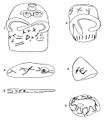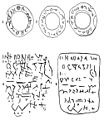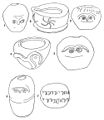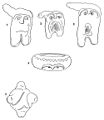Glozel
Glozel is a hamlet in the commune of Ferrières-sur-Sichon in the Allier department , in the Auvergne in central France . Glozel is about 17 kilometers from Vichy .
Glozel is best known as an archaeological site where over 3,000 artifacts were discovered between 1924 and 1930, including clay tablets, sculptures, and vases, some of which are inscribed with symbols and letters. The finds have been dated very differently, assessed as Neolithic , Stone Age or Medieval , and have long been the subject of heated debates among French archaeologists . Many experts originally suspected the find was a fake, but advanced dating methods later confirmed the age of the finds.
Artifacts from Glozel
Discovery and excavation
The artifacts were discovered on March 1, 1924 by the 17-year-old Émile Fradin (* August 8, 1906, † February 10, 2010 at the age of 103) and his grandfather Claude Fradin. While they were plowing their field with a cattle plow, the cow got stuck in a hole. When the cow was freed, the Fradins discovered an underground chamber. This had walls made of clay bricks and 16 clay floor tiles and contained human bones and ceramic fragments.
Adrienne Picandet, a local teacher, visited the Fradins farm that same March and notified the Minister of Education of the discovery. Another teacher, Benoit Clément, was sent on July 9th by the Société d'Émulation du Bourbonnais to have a first look. He later returned with a man named Viple, with whom he removed the remaining walls of the chamber and took them with him for further analysis. Viple later wrote a letter to Émile Fradin, in which he described the site as Gallo-Roman and narrowed the date to 100-400 AD.
In the January edition of the Bulletin de la Société d'Émulation du Bourbonnais the finds were mentioned, whereupon the amateur archaeologist and doctor from Vichy Antonin Morlet began to be interested in them. Morlet visited the farm on April 26th and offered the Fradins 200 francs for the digging rights. The excavation began on May 24, 1925, and clay tablets, statuettes, bones, flint stones and engraved stones were discovered. Morlet wrote under the co-authorship of Émile Fradin a report entitled Nouvelle Station Néolithique , in which he described the site as Neolithic . The report was published in September 1925.
Two more graves were discovered in 1927. As a result, further excavations were carried out in April 1928. After 1941 a new law prohibited private excavations and the site was not touched until 1983. Then it was reopened by the Ministry of Culture. A complete scientific report has not been published to date, but a 13-page summary of the findings and results so far appeared in 1995. The authors of this summary estimate the finds as a whole as medieval (rough dating between 500 and 1500 AD) assume that possibly also forgeries, as well as objects from earlier periods could be among them.
An annual colloquium on Glozel has been held in Vichy, organized by René Germain , since 1999 .
Controversy over Glozel
French archaeologists were very hostile to Morlet's 1925 report because it was written by an amateur archaeologist and a farm boy. In 1926 Morlet invited a number of archaeologists to visit the site, including Salomon Reinach , curator of the National Museum of Saint-Germain-en-Laye , who spent three days excavating. Reinach then confirmed the authenticity of the site in a letter to the Académie des Inscriptions et Belles-Lettres . The prehistorian Henri Breuil was also impressed after he had carried out his own excavations, but later wrote that "everything was fake, except for the stoneware pots."

At the meeting of the International Institute of Anthropology in Amsterdam, which took place in September 1927, Glozel became the subject of heated controversy. A commission was assigned to carry out further inquiries. She arrived in Glozel on November 5, 1927 and carried out excavations for three days. Although onlookers later reported that numerous finds had been made by the archaeologists, the commission described everything except a few flint stones and axes as fakes in its report. René Dussaud, the curator of the Louvre and famous epigraph, accused Émile Fradin of forgery. On January 8, 1928, Fradin sued him for defamation.
Felix Regnault , President of the French Prehistoric Society, visited Glozel on February 24, 1928. After briefly visiting the small museum at the site, he filed charges of fraud. The day after he appeared in the company of the police, who on his instructions searched the museum, destroyed glass exhibition cases and confiscated artifacts. On February 28, 1928 the indictment against Dussaud was postponed because of Regnault's pending complaint.
A new grouping of neutral archaeologists called up by Morlet, the so-called "Comité des études", began to dig again. Between April 12 and 14, 1928, they found further artifacts and confirmed the authenticity of the site, which they assessed to be Neolithic.
Gaston Edmond Bayle , head of the criminal records office in Paris and from 1921 to 1929 head of the laboratory of the Paris Prefecture of Police, analyzed the confiscated artifacts. His report calls these falsifications, and on June 4, 1929, Émile Fradin was charged with fraud. The verdict against Fradin was finally overturned on appeal in April 1931. The defamation suit against Dussaud was heard in March of the following year and he was convicted of defamation.
Dating the artifacts
Glass found in Glozel was spectroscopically dated to the 1920s . The dating was repeated in the University of Toronto's Slowpoke Reactor in the 1990s by neutron activation analysis . Both analyzes confirm that the glass was created in the Middle Ages. Alice and Sam Gerard, together with Robert Liris, dated two leg bones found in Grave II at the University of Arizona in 1995 using the C14 method ; these date from the 13th century.
Thermoluminescence dating of clay pots from Glozel in 1974 confirmed that the pots were not made recently. From 1979, based on 39 TL dating of 27 artefacts, the finds were divided into three groups: the first between 300 BC. BC and 300 ( Celtic or Gallo-Roman ), the second medieval (mainly around the 13th century) and the third present. TL dating, which was carried out in Oxford in 1983, assign the artifacts to the period between the 4th century and the medieval period.
14 C-dates of the bone fragments determine their age between the 13th and 20th centuries. Three 14 C dates, which were carried out in Oxford in 1984, date a piece of coal to the 11th to 13th centuries and a piece of an ivory ring to the 15th century. A human femur was dated to the 5th century.
Glozel's clay tablets
About 100 clay tablets with inscriptions were found in Glozel in total. The inscriptions have an average of six to seven lines, are mostly written on one side and have not yet been fully deciphered.
The symbols on the tablets are reminiscent of the Phoenician alphabet , but have not yet been finally deciphered. There were numerous claims for decipherment, including determining the language of the inscriptions such as Basque , Chaldean , Eteocetan , Turkish , Iberian , Latin , Berber , Ligurian , Phoenician, and Hebrew .
Some archaeologists dated the rune stones to a fantastic age (around 8000 BC). The date was then presented by experts such as Lois Capitan as a clumsy forgery, since around 8000 BC. No well-founded civilization could have existed. Moreover, the arrangement of the characters does not allow the conclusion that this is actually a written language, since no word or sentence structures are recognizable. Attempts were made that resulted in astronomical or cultic texts, but the results are still highly controversial today. The dispute over the dating and even the authenticity of the rune stones continued over the years. When World War II broke out, the discussion about it ended abruptly and the stones were forgotten. Only towards the end of the 1970s did the discussion about the authenticity of the runes arise again. The meanwhile advanced technology made it possible to precisely determine the age of the labeled clay tablets. The oldest find (a bone plate) is around 17,000 years old, other specimens are around 15,000 years old. The clay tablets, on the other hand, were made much later (from around 600 BC).
In 1982 Hans-Rudolf Hitz suggested that the inscriptions were of Celtic origin and dated them between the 3rd century BC. BC and the 1st century. He counted 25 different characters with about 60 variations and ligatures . Hitz's hypothesis states that the alphabet used is the Lepontian version of the Etruscan script , as some words are known from this language. Examples: Setu (Lepontisch Setu-pokios ), Attec (Lepontisch Ati , Atecua ), Uenit (Lepontisch Uenia ), Tepu (Lepontisch Atepu ). Hitz even claims the discovery of a toponym for Glozel , namely nemu chlausei "at the holy place of Glozel" (he compares nemu to the Celtic nemeton ). However, due to their seemingly random arrangement, the rune stones from Glozel are still a mystery to scientists.
literature
- André Cherpillod: Glozel et l'écriture préhistorique. A. Cherpillod, Courgenard 1991, ISBN 2-906134-15-5 .
- Émile Fradin: Glozel et ma vie (= Les Énigmes de l'univers. ). R. Laffont, Paris 1979, ISBN 2-221-00284-9 .
- Herbert Genzmer, Ullrich Hellenbrand: Riddles of Humanity. Parragon Books, Bath 2007, ISBN 978-1-4454-0948-1 .
- Alice Gerard: Glozel. Bones of Contention. iUniverse, New York NY 2005, ISBN 0-595-67067-9 .
- Hans-Rudolf Hitz: When people still spoke protoceltic. Attempt to decipher the Glozel inscriptions. Juris-Druck und Verlag, Zurich 1982, ISBN 3-260-04914-2 .
- Marie Labarrère-Delorme: La Colombe de Glozel. Propositions pour une lecture des inscriptions de Glozel. M. Labarrère-Delorme, Cessy 1992, ISBN 2-9504632-1-5 .
- Salomon Reinach : Éphémérides de Glozel. Kra, Paris 1928, ( digitized ).
- Nicole Torchet, Patrick Ferryn, Jacques Gossart: L'Affaire de Glozel. Copernic, Paris 1978, ISBN 2-85984-021-4 .
- Gigi Sanna: Conferenza di Parigi. Relazione sull'ipotesi di decodificazione dei documenti di Glozel attraverso il codice di scrittura nuragico. I documenti oracolari in lingua greca arcaica di Glozel ed il culto di Apollo IHIOΣ in Delfi. In: Quaderni Oristanesi. No. 53/54, April 2005, pp. 5-50 .
- Gigi Sanna: I segni del lossia cacciatore. Le lettere ambigue di Apollo e l'alfabeto protogreco di Pito. Since Tzricotu (Sardegna) a Delfi (Grecia) percorrendo Glozel (Francia) (= Collana Apollo. 3). S'Alvure, Oristano 2007, ISBN 978-88-7383-294-2 .
Web links
- Glozel Museum website
-
Alice Gerard
- Inscription Corpus (PDF; 695 kB)
- Glozel
- L'Affaire Glozel (Bad Archeology, English)
- La Vache Qui Rit (BBC / Adam Curtis)
- Glozel and Lussac les Châteaux (Journal Infinito)
Individual evidence
- ↑ Émile Fradin obituary. In: Daily Telegraph , March 4, 2010.
- ↑ http://www.elcorreo.com/vizcaya/20131213/mas-actualidad/sociedad/glozel-yacimiento-controversia-201312121829.html
- ↑ Glozel, l'année 1928 ( French ) Musée de Glozel. Retrieved January 17, 2009.
- ↑ Jürgen Thorwald : The hour of the detectives. Becomes and worlds of criminology. Droemer Knaur, Zurich and Munich 1966, p. 352 f. and pp. 356-378.
- ↑ Traducteurs de Glozel de l'entre-deux-guerres
- ^ Traducteurs de Glozel d'après-guerre
- ↑ Traducteurs actuels de Glozel
- ↑ http://www.museedeglozel.com/Trad2030.htm
- ↑ http://www.museedeglozel.com/Trad5090.htm
- ↑ http://www.museedeglozel.com/Trad2000.htm
- ↑ Hans-Rudolph Hitz: The Glozel Writing . Archived from the original on July 23, 2011. Info: The archive link was inserted automatically and has not yet been checked. Please check the original and archive link according to the instructions and then remove this notice. Retrieved July 23, 2011.
- ↑ Hans-Rudolf Hitz: A proof of the authenticity of the inscriptions from Glozel (France). In: Language & Languages. Journal of the Society for Language & Languages. Edition 41, 2010, pp. 50–57 .
- ↑ Reinach: Ephémérides de Glozel. 1928, pl. III.
- ↑ Reinach: Ephémérides de Glozel. 1928, pl. V.
- ↑ a b Reinach: Éphémérides de Glozel. 1928, pl. VI.
- ↑ Reinach: Ephémérides de Glozel. 1928, pl. VIII.
- ↑ Reinach: Ephémérides de Glozel. 1928, pl. IX.
- ↑ Reinach: Ephémérides de Glozel. 1928, pl. X.
- ↑ Reinach: Ephémérides de Glozel. 1928, pl. XI.
Coordinates: 46 ° 2 ′ 21.5 ″ N , 3 ° 36 ′ 28.7 ″ E











